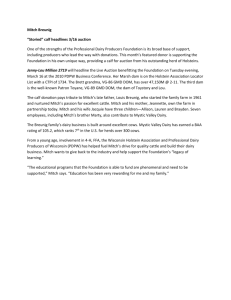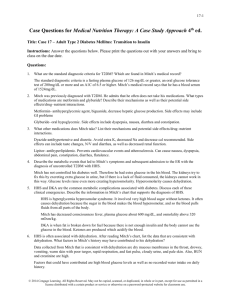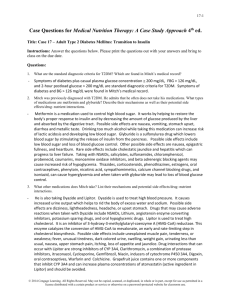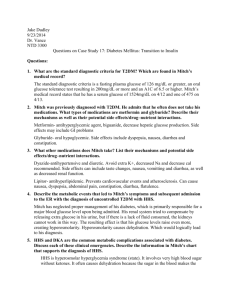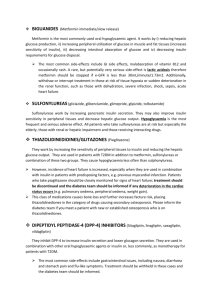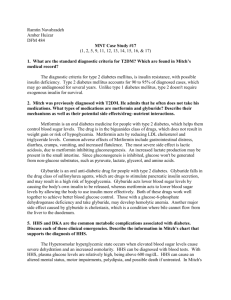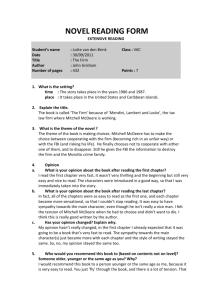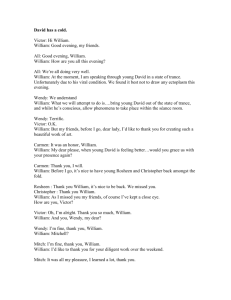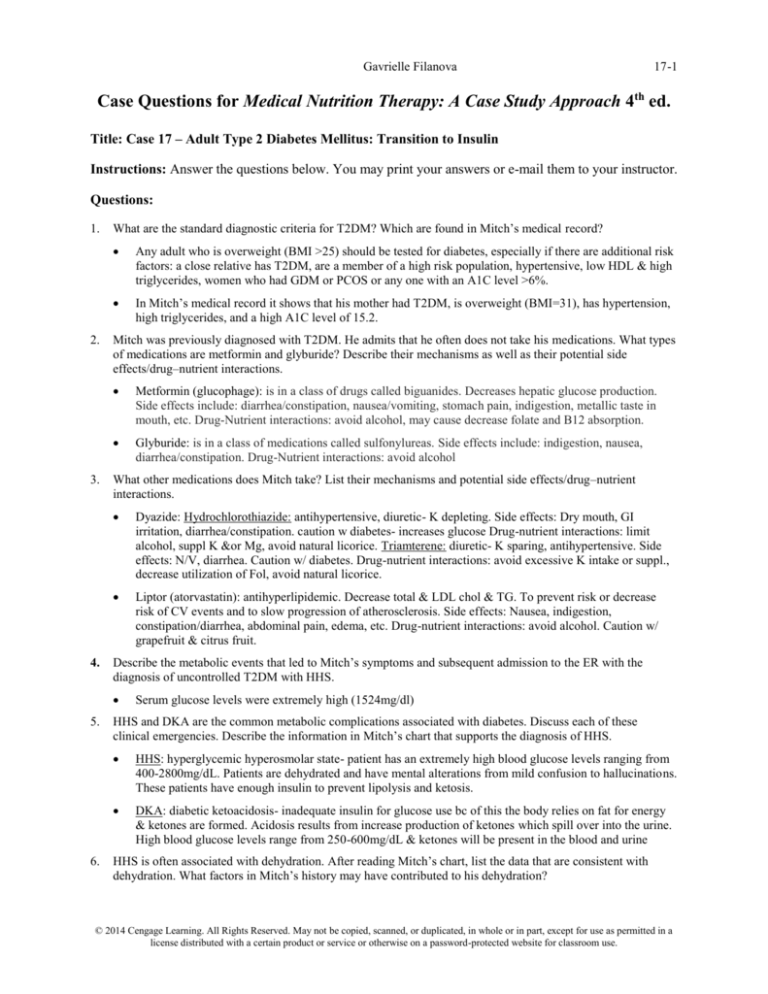
Gavrielle Filanova
17-1
Case Questions for Medical Nutrition Therapy: A Case Study Approach 4th ed.
Title: Case 17 – Adult Type 2 Diabetes Mellitus: Transition to Insulin
Instructions: Answer the questions below. You may print your answers or e-mail them to your instructor.
Questions:
1.
2.
3.
4.
What are the standard diagnostic criteria for T2DM? Which are found in Mitch’s medical record?
Any adult who is overweight (BMI >25) should be tested for diabetes, especially if there are additional risk
factors: a close relative has T2DM, are a member of a high risk population, hypertensive, low HDL & high
triglycerides, women who had GDM or PCOS or any one with an A1C level >6%.
In Mitch’s medical record it shows that his mother had T2DM, is overweight (BMI=31), has hypertension,
high triglycerides, and a high A1C level of 15.2.
Mitch was previously diagnosed with T2DM. He admits that he often does not take his medications. What types
of medications are metformin and glyburide? Describe their mechanisms as well as their potential side
effects/drug–nutrient interactions.
Metformin (glucophage): is in a class of drugs called biguanides. Decreases hepatic glucose production.
Side effects include: diarrhea/constipation, nausea/vomiting, stomach pain, indigestion, metallic taste in
mouth, etc. Drug-Nutrient interactions: avoid alcohol, may cause decrease folate and B12 absorption.
Glyburide: is in a class of medications called sulfonylureas. Side effects include: indigestion, nausea,
diarrhea/constipation. Drug-Nutrient interactions: avoid alcohol
What other medications does Mitch take? List their mechanisms and potential side effects/drug–nutrient
interactions.
Dyazide: Hydrochlorothiazide: antihypertensive, diuretic- K depleting. Side effects: Dry mouth, GI
irritation, diarrhea/constipation. caution w diabetes- increases glucose Drug-nutrient interactions: limit
alcohol, suppl K &or Mg, avoid natural licorice. Triamterene: diuretic- K sparing, antihypertensive. Side
effects: N/V, diarrhea. Caution w/ diabetes. Drug-nutrient interactions: avoid excessive K intake or suppl.,
decrease utilization of Fol, avoid natural licorice.
Liptor (atorvastatin): antihyperlipidemic. Decrease total & LDL chol & TG. To prevent risk or decrease
risk of CV events and to slow progression of atherosclerosis. Side effects: Nausea, indigestion,
constipation/diarrhea, abdominal pain, edema, etc. Drug-nutrient interactions: avoid alcohol. Caution w/
grapefruit & citrus fruit.
Describe the metabolic events that led to Mitch’s symptoms and subsequent admission to the ER with the
diagnosis of uncontrolled T2DM with HHS.
5.
6.
Serum glucose levels were extremely high (1524mg/dl)
HHS and DKA are the common metabolic complications associated with diabetes. Discuss each of these
clinical emergencies. Describe the information in Mitch’s chart that supports the diagnosis of HHS.
HHS: hyperglycemic hyperosmolar state- patient has an extremely high blood glucose levels ranging from
400-2800mg/dL. Patients are dehydrated and have mental alterations from mild confusion to hallucinations.
These patients have enough insulin to prevent lipolysis and ketosis.
DKA: diabetic ketoacidosis- inadequate insulin for glucose use bc of this the body relies on fat for energy
& ketones are formed. Acidosis results from increase production of ketones which spill over into the urine.
High blood glucose levels range from 250-600mg/dL & ketones will be present in the blood and urine
HHS is often associated with dehydration. After reading Mitch’s chart, list the data that are consistent with
dehydration. What factors in Mitch’s history may have contributed to his dehydration?
© 2014 Cengage Learning. All Rights Reserved. May not be copied, scanned, or duplicated, in whole or in part, except for use as permitted in a
license distributed with a certain product or service or otherwise on a password-protected website for classroom use.
17-2
The data in his chart that are consistent with his dehydration status is the osmolality lab which is high. The
factors in his medical history that contributed to his dehydration were the medications that he was on which
made him nausea. He had been vomiting for awhile and couldn’t keep any food and little liquid down. In
his diet recall for the past several months he didn’t list water or much of any other beverage.
7.
Assess Mitch’s intake/output record for the first 24 hours of his admission. What does this tell you? Assuming
that Mitch tells you that his usual weight is 228 lbs, can you estimate the volume of his dehydration?
8.
Mitch was started on normal saline with potassium as well as an insulin drip. Why are these fluids a component
of his rehydration and correction of the HHS?
9.
Describe the insulin therapy that was started for Mitch. What is Lispro? What is glargine? How likely is it that
Mitch will need to continue insulin therapy?
Lispro: bolus insulin; a fast- acting insulin analogue. Engineered through rDNA which allows for larger
amounts of insulin to be immediately available for postprandial injections. Has a shortened delay of onset,
allowing more flexibility than regular insulin, which requires a longer waiting period before starting a meal
after injection.
Glargine: basal insulin; a long-acting insulin analogue given once daily to help control blood glucose
levels. Slow release insulin, has a longer duration of 18-26 hrs without the peak and drop.
10. Mitch was NPO when admitted to the hospital. What does this mean? What are the signs that will alert the RD
and physician that Mitch may be ready to eat?
NPO: nil per os or nothing by mouth. When his hydration status and glucose levels are better under control
he can progress to liquids and then solid food.
11. Outline the basic principles for Mitch’s nutrition therapy to assist in control of his DM.
He needs to be on a diabetic, carbohydrate controlled diet. Calories would be approx. 2,200 for weight loss.
This means he can have about13 carb exchanges throughout the day to keep his blood sugar consistent.
12. Assess Mitch’s weight and BMI. What would be a healthy weight range for Mitch?
When he entered the hospital his wt was 97kg, BMI=31.6kg/m2 making him mildly obese.
A healthy weight range for him would be between 150-170lbs, BMI range 22-25kg/m2
13. Identify and discuss any abnormal laboratory values measured upon his admission. How did they change after
hydration and initial treatment of his HHS?
Sodium, BUN, Creatinine, glucose, phosphate & Osmolality were all labs that had abnormal values upon
admission. After treatment they all were improving but were still not in the range required for health.
14. Determine Mitch’s energy and protein requirements for weight maintenance. What energy and protein intakes
would you recommend to assist with weight loss?
Energy requirements: TEE= 1086-10.1x age(yrs) +PA(13.7x wt[kg] +416 x ht[m])
=1086-10.1 x53 +1 (13.7x 97.2 +416x 1.75) = 2610.3 calories for wt
maintenance
Protein requirements: 0.8g per kg wt= 0.8 x 97.2 = 77g
For weight loss of 1 lb per wk, subtract 500 cal per day from total energy requirements (total calories
would equal approx. 2110)
15. Prioritize two nutrition problems and complete the PES statement for each.
Inconsistent carbohydrate intake related to Food &nutrition related knowledge deficit concerning
appropriate timing of carb intake as evidenced by glucose 1524mg/dL & 475mg/dL
© 2014 Cengage Learning. All Rights Reserved. May not be copied, scanned, or duplicated, in whole or in part, except for use as permitted in a
license distributed with a certain product or service or otherwise on a password-protected website for classroom use.
Gavrielle Filanova
17-3
Inadequate fluid intake related to physiological causes increasing fluid needs due to conditions leading to
fluid loss as evidenced by specific gravity 1.045, osmolality 360mmol/kg/h20, abnormal BUN & NA
levels.
16. Determine Mitch’s initial CHO prescription using his diet history as well as your assessment of his energy
requirements.
See attached
17. Identify two initial nutrition goals to assist with weight loss.
Carbohydrate controlled diet.
Consume carbs consistently throughout the day
18. Mitch also has hypertension and high cholesterol levels. Describe how your nutrition interventions for diabetes
can include nutrition therapy for his other conditions.
Diabetic diets and cardiac diets are similar and Mitch’s diabetic diet could help him with his hypertension
and high cholesterol levels. By having him having him watch and be more aware of what he eats it could
help him lose some weight and be beneficial for his HTN & high cholesterol.
19. Write an ADIME note for your initial nutrition assessment. (Assessment Diagnosis Intervention Monitoring
Evaluation).
Assessment: pt has T2DM along w/ HTN & high cholesterol-doesn’t take DM medication consistently
Diagnosis: pt has extremely high blood glucose accompanied by dehydration
Intervention: Rehydrate & lower blood glucose. Teach pt diabetes education; to consume carbs consistently
throughout the day for better blood glucose control
Monitoring: monitor blood glucose levels, osmolality & specific gravity for levels to return to normal.
Monitor any other abnormal lab results.
Evaluation: See pt in 3 mons to assess levels & how new lifestyle is working.
© 2014 Cengage Learning. All Rights Reserved. May not be copied, scanned, or duplicated, in whole or in part, except for use as permitted in a
license distributed with a certain product or service or otherwise on a password-protected website for classroom use.



